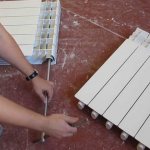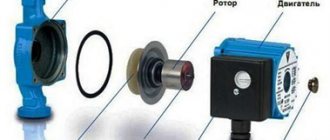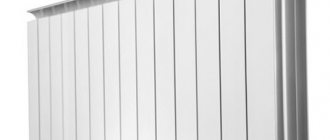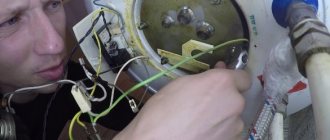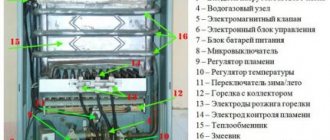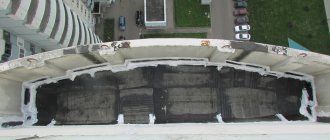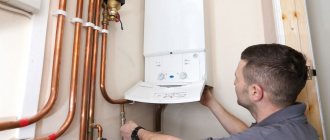The service life of cast-iron heating radiators is so long that residents take their work for granted, therefore, in the event of a leak or fistula in the wall of the device, they do not know what to do. It is especially unpleasant if the breakdown occurred in the midst of cold weather, but even in the off-season, you cannot leave the heating elements unattended. As a rule, preventive work carried out by heating network workers can reveal the presence of dirt or leaks in the device.
In this case, there are simple ways to eliminate a leak in a cast iron radiator.
The device of cast iron radiators
This type of heating device consists of sections. Models of the old type even today are produced in the form of "accordions", while the new generation has a flat outer panel that provides better heating of its entire area.
During operation, these devices use two types of heat transfer:
- Radiation, or as professionals call it, radiation makes up 25-30% of the heat. It not only heats the air, but is transmitted to nearby objects, providing a better heating of the room.
- The convection produced by the heating battery ensures the constant movement of air masses around the room, and accounts for about 75% of the heat transfer.
The device of the cast-iron battery, despite all the external changes, remained the same. It consists of sections equipped with:
- plugs;
- locking devices;
- traffic jams;
- shank and thermostat;
- locknuts;
- nipples and gaskets.
As strong as cast iron is, even it has its limits. As a rule, the service life of cast iron radiators is 25-30 years, and with proper care and optimal working conditions, they can work without interruption from 50 to 100 years.
The same cannot be said for the parts that hold the sections together, such as the gaskets. With frequent water hammer, they can "wobble" or crack from time to time. In this case, a leak appears between the sections of the cast-iron battery, which, if not eliminated in time, can cause a serious accident and a threat to human health and life.
To avoid this, you need to check the condition of the cast iron radiators after the end of the heating season. In this case, you can find completely different malfunctions in the heating system.
https://youtu.be/hsafUiN-Cfw
The most common problems and their symptoms
Although cast iron perfectly tolerates the imperfection of the central heating coolant, and the batteries from it have channels wide enough so that debris does not accumulate in them, even they may have problems. And this despite the fact that this metal has no wear. The following factors may be responsible for the fact that the cast-iron battery burst or a fistula appeared in its walls:
- Everyone knows the large weight of radiators made of this metal. If, during the installation of the structure, not strong enough brackets were used, or there were few of them, over time it can sag under its own weight and bend over. Even a slight deviation by just a couple of millimeters will reduce the efficiency of the device, and if the imbalance is not corrected, then after a few years, corrosion will appear in the place where the coolant is absent. At first, it will look like a small brown speck that will grow with each heating season until a fistula forms in its place.
- The reputation of "long-livers" is characteristic of both old and new models of cast-iron radiators, but provided that they are mounted in the circuit of an apartment building no higher than six floors. If the heating system is reliable and does not “sin” with strong water hammer, then they can be installed in nine-storey buildings. Otherwise, under a strong pressure of water, a cast-iron battery can leak at the joints of the sections. In the event that a cast-iron battery leaks during the heating season, you need to know how to repair it in advance. Today there are a lot of sealants that will help the device "hold out" until warm days.
- The internal structure of domestic batteries is such that the cast iron from which they are smelted has roughness that is completely absent in imported counterparts. That is why, over time, a lot of debris is deposited on the walls, with which the water in the heating network is filled. Suspensions, particles of rust and metals, all this settles and makes the wide channel so narrow that it is no longer able to pass the coolant unhindered under high pressure. In this case, the structure can burst anywhere, and then you will have to urgently decide how to eliminate the leak in the cast-iron battery.
- Gaskets and nipple threads are the weak "link" of heating devices... If cast iron does not have a limitation period, then this cannot be said about the parts that make up the battery. In order not to bring the situation to the point that the repair of the cast-iron battery is required, the joints must be checked after each heating season and the gaskets must be periodically changed on them.
As practice shows, most often it becomes known that something is wrong with the heating system when the repair of cast-iron radiators is already required. To know about a problem in advance, you need to listen for "help signals" that indicate the presence of defects.
The first signs of a problem
There are a number of factors that indicate that something is wrong with the heating circuit or batteries. These include:
- Feeling cool in the room. In this case, it is worth asking the neighbors how warm they are in the apartment. If everything is in order, then you can start looking for problems in yourself. The reason may be elementary contamination of the channels, the skew of the device or the presence of fistulas. In the first case, it is enough to rinse the batteries, in the second - to fix or change the brackets and check the correctness of installation with a building level, and in the third - to help the "sick" radiator.
- If an incomprehensible plaque appears on the battery, visible to the naked eye, then the reason for this is worn out gaskets. We'll have to turn off the system, dismantle the batteries and install new ones, for example, made of paronite.
- The leak is immediately noticeable. If it is small, then you can do with a clamp or cold welding, otherwise you will have to completely change the device.
It should be remembered that even small defects can develop into a big problem if they are not eliminated in time. Do not rely on temporary clamps and patches. Only heating specialists can determine the reliability and tightness of the heating circuit and its elements.
Bimetal battery repair
If you decide to repair bimetallic heating radiators with your own hands, then follow the recommendations of experts. Despite the strength, quality and durability of bimetal heating devices, they also fail due to the poor quality of the coolant in centralized heating networks.
If the heat transfer of a bimetallic device decreases, then the cause may be clogged pipes. To solve the problem, you need to clean the device and pipelines.

When cleaning bimetallic radiators, follow a certain sequence of actions:
- If the radiator is mounted on bypasses, then disconnect the battery circuit from the heating system. Otherwise, you will have to block off the whole riser or the whole house. Move furniture aside if it gets in the way and cover the floor with plastic wrap.
- Use a pipe wrench to disconnect the heater from the main line.Place a basin and drain the water from the appliance by tilting it over the container. Then take the radiator to the bathroom. It is much more convenient to clean it here. Place a wooden pallet or rags on the bottom of the bathroom to avoid scratching the plumbing.
- Remove any plugs from the battery and apply high pressure water to the battery. It is necessary to rinse the radiator until various contaminants cease to be washed out. If the scale is so dense that the water jet cannot penetrate it, special chemical compounds will be needed. You can use "Mole" or pour vinegar into the battery overnight. After the scale dissolves, the unit is washed again with clean water.
- Then all the plugs are returned to their original place and the battery is installed in the circuit by connecting it to the line.
We repair cracks in bimetallic radiators
If a crack appears in a bimetal device, then it will not work simply to weld it, because an oxide film will appear on the aluminum case in this place. Its appearance is associated with the interaction of aluminum with oxygen. To solve the problem of the appearance of the film, a flux is used. A special compound for brazing aluminum is sold in stores. If you wish, you can do it yourself.
When the problem of oxide formation is solved, traditional brazing is carried out with a solder from an iron-rosin mixture. Small damage (crack or small hole) can be repaired by brazing. If you decide to contact the master, then cold welding or epoxy glue is used to temporarily eliminate the leak.
Replacing heating pipes in an apartment and how to hide them
Fistula elimination
For any breakdown, there are a number of reasons accompanying it. Fistulas on the pipes of the heating system or on the radiator are no exception. If a small brown speck appears on the elements of the heating network, you should not think that this is the paint coming off. In fact, this is the beginning of an often irreversible process, but knowing how to close a fistula in a cast-iron battery, you can stop the destruction and extend its service life. Reasons for the appearance of corrosion:
- Taking into account the frequent increases in the cost of utilities, some craftsmen are cunning and, for the sake of saving electricity, connect a zero cable to the heating circuit. The currents that begin their "journey" through the pipes by means of the coolant exactly cause the formation of corrosion. It is possible to identify a dishonest neighbor if there are several fistulas, and they appear with a certain regularity. A call to the appropriate service will help to save the situation in order to identify the offender, and do-it-yourself repair of cast iron batteries.
- Too high acidity of water can harm even corrosion-tolerant cast iron.
- The batteries have expired or deposits on the sides have damaged the metal. In this case, even a small fistula or crack under the influence of water pressure can cause the battery to burst and a stream of hot water will flow out of it.
Any of the options requires urgent intervention. If the cast-iron battery only leaks slightly, then you can do without disconnecting the circuit and dismantling it. The clamp can save the situation. If the water only drips, then a one-sided pad will do, but if it runs in a thin line, then it is better not to risk it and use a double-sided clip.
In the event that the coolant tore apart the place where the fistula was located, the question immediately arises whether it is possible to brew a cast-iron battery... As a rule, cold welding becomes an emergency aid, but even if it has restored its tightness, it is necessary to call the masters from the heating network to check the condition of the heating system.
Repair of bimetallic heating radiators
Restoration, replacement and repair of bimetallic heating radiators begins with the preparation of tools. Next, shut off the water supply and drain off the leftovers.After removing the old device, it is necessary to make a markup to install a new one. We install the brackets and, having unscrewed all the plugs, we mount a new device. With a one-pipe connection, we connect the bypass. We connect the battery to the system with grips and seal the joints with seals.
You can learn more about the replacement and intricacies of repair work from the video on repairing heating radiators with your own hands.
Methods for repairing cast iron radiators
There are several methods that allow the batteries to hold out not only until the end of the heating season, but also for a couple of years. These include:
- If a leak occurs at the junction of the sections, then it can be quickly eliminated with a bandage and epoxy glue. The material is impregnated with glue and wound around the leak. After it grabs, you can paint over this place in the tone of the battery, but the main thing to remember is that such an "operation" is considered temporary, and it is better to buy and install a new section after the end of the cold weather.
- If a fistula or crack is found, a clamp will be required. You can buy it at a building materials store, or you can make it yourself from rubber or tin.
- Cold welding for cast iron batteries is the best way to quickly fix a defect. This is a special sealant that looks like children's plasticine. It must be thoroughly kneaded and applied to the damaged area. The tool sets quickly, is resistant to temperature extremes and is quite suitable for quick and temporary repair of a cast-iron battery.
Knowing how to weld a cast-iron battery using a welding machine with an inverter circuit, you can save the device from leaks for a long time.
Sequence of work
Depending on how serious the breakdown is, the actions to eliminate it depend. So, if the leak is small, then you can do without disconnecting the battery from the circuit, and repair will require:
- Place a container under the place of breakage in case of a breakthrough or an oilcloth with a rag to collect water.
- The place of the gap or crack must be cleaned to the base with a cable or emery. It is necessary not only to remove the paint layer, but to expose the metal itself.
- Degrease the prepared area with some kind of solvent.
- If special glue or epoxy is used to eliminate the breakage, then strips of thick cloth or bandages will be required. Apply the product to them and wrap them in several layers over the gap.
- In the case of cold welding, no fabric is needed.
- A clamp is put on and screwed onto the place seized by the sealant, but it is important to make sure that its clamps are on the opposite side of the leak. For example, a crack has formed on the inside of the radiator, which means that the clamps will be on the outside, and vice versa.
- If the breakdown is serious and hot water gushes from the battery, then you need to call the emergency team, and not try to stop the leak yourself without the necessary tools.
Even the highest quality repair does not guarantee a long service life of the device. The restored cast-iron radiators will still have to be changed, and the sooner this is done, the safer it will be in the apartment.
Types of heating batteries
If you plan to repair heating radiators with your own hands, then the type of work performed depends on the type of battery.


Depending on the materials, all heating devices are divided into the following types:
- Aluminum units are lightweight, look very attractive and have a high heat transfer. However, they do not tolerate water hammer well, therefore they are installed only in autonomous heating systems with low pressure. Also, the purity and composition of the coolant are important for them. If deposits appear on the inner walls, the radiator cannot be repaired, therefore, the purity of the coolant must be constantly monitored.
- Sectional cast iron batteries have a high heat capacity. They are durable and durable, and they are also not subject to corrosion.Due to the impressive weight of the device, installation and maintenance cause certain difficulties. Such radiators often leak due to the wear of the gaskets between the sections.
- Steel radiators weigh a little and have good heat dissipation. However, in buildings with centralized heating, they are not installed due to their susceptibility to corrosion after draining the coolant from the system.
- Bimetallic batteries have a steel core and an aluminum body. They are very beautiful outwardly, resistant to corrosion and high pressure in the system, so they can be used in houses with centralized heating. The heat transfer of the bimetallic radiator is quite high. Repairing heating in an apartment with bimetallic devices is easy to do with your own hands, if you know how to replace and adjust thermostats, eliminate a leak, clean pipes and change gaskets.
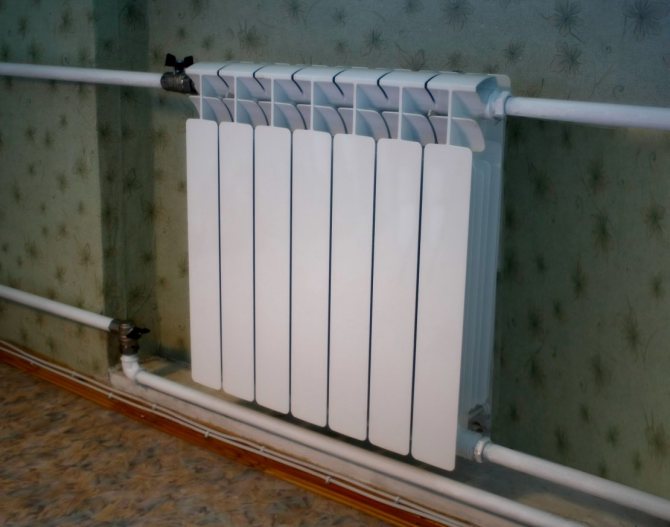

To choose a suitable type of heating device, you need to take into account the wiring diagram, piping material, installation features, coolant temperature, room layout and number of storeys of the house, as well as the climatic features of the region.
When choosing a battery, pay attention to its dimensions. Be sure to install a shut-off and control temperature. To correctly count the number of sections, use the following rule - for every two squares of a room with a height of no more than three meters, you need to install one section.
In multi-storey buildings, bimetallic or cast-iron radiators are usually installed, which can easily withstand water hammer and increased pressure in the network. That is why we will tell you in detail how to repair bimetal and cast iron heating batteries.
